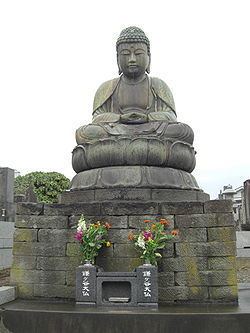Area 21.08 km² Local time Saturday 5:07 PM | Region Kantō Phone number 047-445-1141 Population 107,853 (2010) | |
 | ||
- Flower Japanese pear and Japanese bellflower Weather 12°C, Wind SW at 6 km/h, 48% Humidity Points of interest Kamagaya Great Buddha, Kaigarayama Park, Shisei Memorial Park, Hayashimizu Park | ||
Kamagaya (鎌ヶ谷市, Kamagaya-shi) is a city in northern Chiba Prefecture, Japan.
Contents
- Map of Kamagaya Chiba Prefecture Japan
- Geography
- Neighboring municipalities
- History
- Economy
- Education
- Railway
- Highway
- Local attractions
- Sister city relations
- References
Map of Kamagaya, Chiba Prefecture, Japan
As of December 1, 2015, the city had an estimated population of 108,392 and a population density of 5,140 persons per km2. The total area was 21.08 km2 (8.14 sq mi).
Geography
Kamagaya is located in the northwestern corner of Chiba Prefecture.
Neighboring municipalities
Chiba Prefecture
History
The area around Kamagaya has been inhabited since prehistory, and archaeologists have found Jōmon period shell middens in the area. During the Kamakura period, the area was controlled by the Sōma clan. Kamagaya flourished in the Edo period 1603–1868 when the area was largely tenryō territory within Shimōsa Province controlled directly by the Tokugawa shogunate. One part of present-day Kamagaya was part of the Kogane Ranch, which raised war horses for the army of the Tokugawa shogunate. In the Edo period Kamagaya was also a thriving shukuba post on the Kioroshi Road, which connected present-day Inzai on the Tone River to Edogawa-ku in Tokyo. The road was utilized to bring fresh fish and other marine products from the Tone River region to the capital Edo. After the Meiji Restoration, it became part of Chiba Prefecture. Kamagaya Village was one of several villages created on April 1, 1889 under Inba District. In 1945, the Imperial Japanese Army appropriated the former Musashino Country Club, turning the golf course into an air field. The base was turned over to the United States Air Force after World War II, becoming Shiroi Air Base, and was transferred to the Japan Maritime Self-Defense Force in 1959, becoming JMSDF Shimofusa Air Base. Kamagaya became a town on August 1, 1968, and was elevated to city status on September 1, 1971.
Economy
Kamagaya, formerly a farming area, is now a regional commercial center. Due to its numerous train connections it serves as a transportation hub and bedroom community for nearby Chiba and Tokyo. Kamagaya's trademark produce is the round, Nashi Pear, and there are many pear orchards dotted about the city, whose white blossoms open toward the end of the cherry blossom season.
Education
The city operates five junior high schools and nine elementary schools. Kamagaya has two public high schools, operated by the Chiba Prefectural government.
